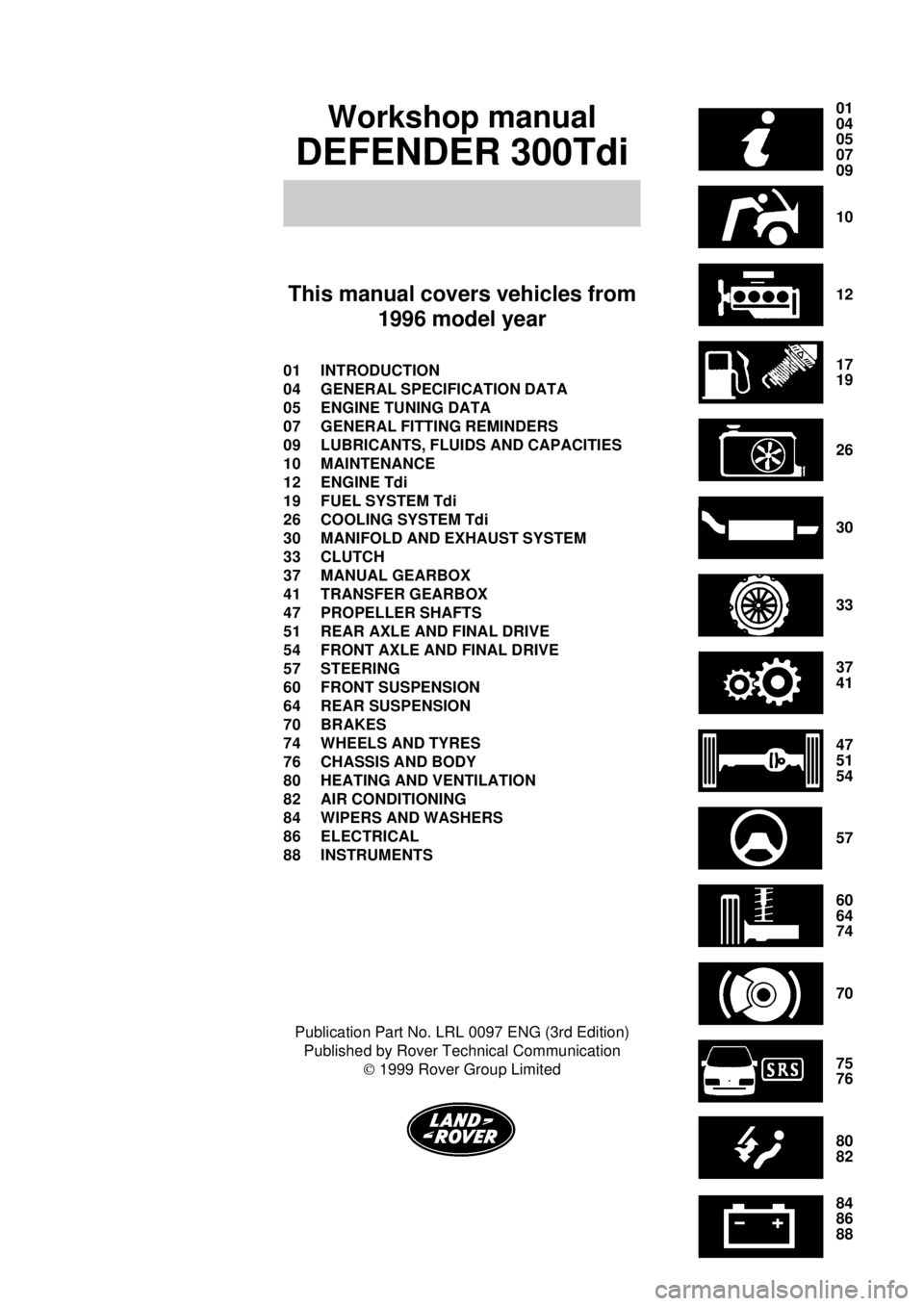air condition LAND ROVER DEFENDER 1996 Workshop Manual
[x] Cancel search | Manufacturer: LAND ROVER, Model Year: 1996, Model line: DEFENDER, Model: LAND ROVER DEFENDER 1996Pages: 455, PDF Size: 6.44 MB
Page 5 of 455

01
04
05
07
09
10
12
17
19
26
30
33
37
41
47
51
54
57
60
64
74
70
75
76
80
82
84
86
88Workshop manual
DEFENDER 300Tdi
This manual covers vehicles from
1996 model year
01 INTRODUCTION
04 GENERAL SPECIFICATION DATA
05 ENGINE TUNING DATA
07 GENERAL FITTING REMINDERS
09 LUBRICANTS, FLUIDS AND CAPACITIES
10 MAINTENANCE
12 ENGINE Tdi
19 FUEL SYSTEM Tdi
26 COOLING SYSTEM Tdi
30 MANIFOLD AND EXHAUST SYSTEM
33 CLUTCH
37 MANUAL GEARBOX
41 TRANSFER GEARBOX
47 PROPELLER SHAFTS
51 REAR AXLE AND FINAL DRIVE
54 FRONT AXLE AND FINAL DRIVE
57 STEERING
60 FRONT SUSPENSION
64 REAR SUSPENSION
70 BRAKES
74 WHEELS AND TYRES
76 CHASSIS AND BODY
80 HEATING AND VENTILATION
82 AIR CONDITIONING
84 WIPERS AND WASHERS
86 ELECTRICAL
88 INSTRUMENTS
Publication Part No. LRL 0097 ENG (3rd Edition)
Published by Rover Technical Communication
Ó1999 Rover Group Limited
Page 6 of 455

INTRODUCTION
1
INFORMATION REV: 05/99 INTRODUCTION
This workshop manual covers vehicles from 1996
model year onwards. Amendments and additional
pages will be issued to ensure that the manual covers
latest models. Amendments and additions will be
identified by the addition of a dated footer at the
bottom of the page.
This Workshop Manual is designed to assist skilled
technicians in the efficient repair and maintenance of
Land Rover Defender 300Tdi, Td5, and V8i vehicles.
Individuals who undertake their own repairs should
have some skill and training, and limit repairs to
components which could not affect the safety of the
vehicle or its passengers. Any repairs required to
safety critical items such as steering, brakes,
suspension or supplementary restraint system should
be carried out by a Land Rover Dealer. Repairs to
such items should NEVER be attempted by untrained
individuals.
WARNINGS, CAUTIONSandNOTESare given
throughout this Manual in the following form:
WARNING: Procedures which must be
followed precisely to avoid the possibility
of personal injury.
CAUTION: This calls attention to
procedures which must be followed to
avoid damage to components.
NOTE: This calls attention to methods
which make a job easier or gives helpful
information.
DIMENSIONS
The dimensions quoted are to design engineering
specification. Alternative unit equivalents, shown in
brackets following the dimensions, have been
converted from the original specification.REFERENCES
References to the left or right hand side in the manual
are made when viewing the vehicle from the rear.
With the engine and gearbox assembly removed, the
crankshaft end of the engine is referred to as the front.
To reduce repetition, some operations covered in this
Manual do not include reference to testing the vehicle
after repair.
It is essential that work is inspected and tested after
completion and if necessary a road test of the vehicle
is carried out, particularly where safety related items
are concerned.
REPAIRS AND REPLACEMENTS
When replacement parts are required it is essential
that Land Rover parts are used.
Attention is particularly drawn to the following points
concerning repairs and the fitting of replacement parts
and accessories: Safety features embodied in the
vehicle may be impaired if other than Land Rover
parts are fitted. In certain territories, legislation
prohibits the fitting of parts not to the vehicle
manufacturer's specification. Torque spanner values
given in the Workshop Manual must be strictly
adhered to. Locking devices, where specified, must be
fitted. If the efficiency of a locking device is impaired
during removal it must be replaced with a new one.
Certain fasteners must not be re-used. These
fasteners are specified in the Workshop Manual.
POISONOUS SUBSTANCES
Many liquids and other substances used are
poisonous and therefore must not be consumed. It is
also advisable to keep all substances away from open
wounds. These substances among others include
anti-freeze, brake fluid, fuel, windscreen washer
additives, air conditioning refrigerant, lubricants and
various adhesives.
Page 8 of 455

INTRODUCTION
3
INFORMATION SYNTHETIC RUBBER
Many 'O' ring seals, flexible pipes and other similar
items which appear to be natural rubber are made of
synthetic materials called Fluoroelastomers. Under
normal operating conditions this material is safe, and
does not present a health hazard. However, if the
material is damaged by fire or excessive heat, it can
break down and produce highly corrosive Hydrofluoric
acid which can cause serious burns on contact with
skin. Should the material be in a burnt or overheated
condition handle only with seamless industrial gloves.
Decontaminate and dispose of the gloves immediately
after use.
If skin contact does occur, remove any contaminated
clothing immediately and obtain medical assistance
without delay. In the meantime, wash the affected
area with copious amounts of cold water or limewater
for fifteen to sixty minutes.
RECOMMENDED SEALANTS
A number of branded products are recommended in
this manual for use during maintenance and repair
work.
These items include:
HYLOMAR GASKET AND JOINTING COMPOUND
and
HYLOSIL RTV SILICONE COMPOUND.
They should be available locally from garage
equipment suppliers. If there is any problem obtaining
supplies, contact the following company for advice
and the address of the nearest supplier.
MARSTON LUBRICANTS LTD.
Hylo House,
Cale Lane,
New Springs,
Wigan WN2 1JR
Tel 01942 824242USED ENGINE OIL
WARNING: Prolonged and repeated
contact with engine or motor oil will result
in the removal of natural fats from the
skin, leading to dryness, irritation and dermatitis.
Used engine oil contains potentially harmful
contaminants which may cause skin cancer.
Adequate means of skin protection and washing
facilities should be provided.
Handling precautions
1.Avoid prolonged and repeated contact with oils,
particularly used engine oils.
2.Wear protective clothing, including impervious
gloves where applicable.
3.Do not put oily rags in pockets.
4.Avoid contaminating clothes, particularly
underwear, with oil.
5.Overalls must be cleaned regularly. Discard
unwashable clothing and oil impregnated
footwear.
6.First aid treatment must be obtained immediately
for open cuts and wounds.
7.Use barrier creams, before each work period, to
help the removal of oil from the skin.
8.Wash with soap and water to ensure all oil is
removed (skin cleansers and nail brushes will
help). Preparations containing lanolin replace the
natural skin oils which have been removed.
9.Do not use gasoline, kerosene, diesel fuel,
petrol, thinners or solvents for washing the skin.
10.If skin disorders develop, obtain medical advice.
11.Where practicable, degrease components prior
to handling.
12.Where there is a risk of eye contact, eye
protection should be worn, for example, goggles
or face shields; in addition an eye wash facility
should be provided.
Disposing of used oils
Environmental protection precaution
It is illegal to pour used oil onto the ground, down
sewers or drains, or into waterways.
Dispose of used oil through authorised waste disposal
contractors. If in doubt contact your Local Authority for
advice on disposal facilities.
Page 15 of 455

01INTRODUCTION
10
INFORMATION CROSS REFERENCE OF EMISSION SYSTEM
TERMINOLOGY
NEW TERM (ACRONYM)
Accelerator pedal (AP).................................................
Air cleaner (ACL)..........................................................
Air conditioning (AC)....................................................
Battery positive voltage (B+)........................................
Closed loop (CL)..........................................................
Closed throttle position (CTP)......................................
Canister purge valve (CANPV)....................................
Data link connector (DLC)...........................................
Diagnostic trouble code (DTC).....................................
Distributor ignition (DI).................................................
Engine control module (ECM)......................................
Engine coolant level (ECL)...........................................
Engine coolant temperature (ECT)..............................
Engine coolant temperature sensor (ECTS)................
Engine speed (RPM)....................................................
Evaporative emission system (EVAP)..........................
Engine fuel temperature sensor (EFTS)......................
4th gear, 3rd gear etc. (4GR, 3GR)..............................
Fuel pump (FP)............................................................
Fan control module (FCM)...........................................
Generator (GEN)..........................................................
Ground (GND)..............................................................
Heated oxygen sensor (H02S)....................................
Idle air control (IAC)......................................................
Idle air control valve (IACV).........................................
Ignition control module (ICM).......................................
Intake air temperature (IAT).........................................
Manifold vacuum zone (MVZ)......................................
Mass air flow sensor (MAFS).......................................
Open loop (OL)............................................................
Relay module (RM)......................................................
Solid state relay module (SSRM).................................
Three way catalytic converter (TWC)..........................
Throttle body (TB)........................................................
Throttle position sensor (TPS)......................................
Transmission range (TR)..............................................
Wide open throttle (WOT)............................................OLD TERM (ACRONYM)
Throttle pedal (-)..........................................................
Air cleaner (-)...............................................................
Air conditioning (AC)....................................................
Battery plus, bat +, bat feed (B+).................................
Closed loop (-).............................................................
Closed throttle, idle position (-)....................................
Charcoal canister purge valve (-).................................
Serial link (-)................................................................
Fault code (-)...............................................................
Electronic ignition (-)....................................................
Electronic control unit (ECU)........................................
Coolant level (-)...........................................................
Coolant temperature (temp).........................................
Coolant temperature thermistor (-)..............................
Engine speed (rev/min)................................................
Evaporative loss system (ELC)...................................
Fuel temperature thermistor (-)....................................
Fourth gear, 3rd gear (-)..............................................
Fuel pump (-)...............................................................
Condenser fan timer (-)................................................
Alternator (-)................................................................
Ground, earth (B-)........................................................
Lambda (02) sensor (-)................................................
Idle speed control (ISC)................................................
Stepper motor (-).........................................................
Ignition module (-)........................................................
Intake temperature/ambient temperature (-)................
Manifold depression, vacuum (-).................................
Air flow meter (-)..........................................................
Fault code display unit (-)............................................
Open loop (-)...............................................................
Relay (-).......................................................................
Control unit (-)..............................................................
Catalyst, catalytic converter (CAT)..............................
Throttle housing (-)......................................................
Transmission gear (-)...................................................
Full throttle, wide open throttle (WOT).........................
Page 25 of 455

GENERAL SPECIFICATION DATA
7
INFORMATION AIR CONDITIONING
System CFC free expansion valve system.............................................................................
Compressor Sanden TRS105N.....................................................................
Refrigerant R134a CFC free.......................................................................
Charge quantity 1.1 Kg................................................................
WIPER MOTORS
Tailgate wiper motor
Make/type IMOS (non-serviceable)........................................................................
Running current, wet screen at 20°C ambient 1.0 to 2.8 amps.................
Wiper speed, wet screen at 20°C ambient 37 to 43 cycles per minute.......................
Windscreen wiper motor
Make/type Lucas 14W uprated two speed........................................................................
Armature end float 0,1 to 0,2 mm............................................................
Brush length, minimum 4,8 mm....................................................
Brush spring tension 140 to 200 g........................................................
Resistance of armature winding
at 16ÊC (69ÊF) measured between adjacent
commutatator segments 0.23 to 0.35 ohms...................................................
Light running, rack disconnected: current at 13.5 V 2.0 amps.........
Wiper speed, wet screen, 60 seconds from cold Low speed - 45±3 rev/min, High speed - 65±5 ..............
rev/min
ELECTRICAL
System 12 volt, negative ground.............................................................................
Battery
Make/type - standard Land Rover Parts and Equipment/Lucas maintenance.......................................................
free 9-plate 072
Make/type - heavy duty Land Rover Parts and Equipment/Lucas maintenance....................................................
free 14-plate 663
Generator
Manufacturer Magnetti Marelli....................................................................
Type A127 - 100amp.................................................................................
Polarity Negative ground.............................................................................
Brush length:
New 17 mm.........................................................................
Worn, minimum free protrusion from moulding 5 mm........
Brush spring pressure flush with moulding 1.3N to 2.7N......................
Regulator voltage 13.6 to 14.4 volts.............................................................
Nominal output
Generator speed 6000 rev/min.....................................................
Control voltage 14 volt........................................................
Amp 65 amp.........................................................................
Page 33 of 455

GENERAL FITTING REMINDERS
1
INFORMATION GENERAL FITTING REMINDERS
WORKSHOP SAFETY IS YOUR RESPONSIBILITY!
The suggestions, cautions and warnings in the
section are intended to serve as reminders for
trained and experienced mechanics. This manual
is not a definitive guide to automotive mechanics
or workshop safety.
Shop equipment, shop environment, and the use
and disposal of solvents, fluids, and chemicals
are subject to government regulations which are
intended to provide a level of safety. It is your
responsibility to know and comply with such
regulations.
PRECAUTIONS AGAINST DAMAGE
1.Always fit covers to protect fenders before
commencing work in engine compartment.
2.Cover seats and carpets, wear clean overalls
and wash hands or wear gloves before working
inside vehicle.
3.Avoid spilling hydraulic fluid or battery acid on
paint work. Wash off with water immediately if
this occurs. Use Polythene sheets to protect
carpets and seats.
4.Always use a recommended Service Tool where
specified.
5.Protect temporarily exposed screw threads by
replacing nuts or fitting plastic caps.SAFETY PRECAUTIONS
1.Whenever possible, use a lift when working
beneath vehicle, in preference to jacking. Chock
wheels as well as applying parking brake.
WARNING: Do not use a pit when
removing fuel system components.
2.Never rely on a jack alone to support vehicle.
Use axle stands carefully placed at jacking
points to provide rigid support.
3.Ensure that a suitable form of fire extinguisher is
conveniently located.
4.Check that any lifting equipment used has
adequate capacity and is fully serviceable.
5.Disconnect battery.
WARNING: Do not disconnect any pipes in
air conditioning system, unless trained
and instructed to do so. A refrigerant is
used which can cause blindness if allowed to
contact eyes.
6.Ensure that adequate ventilation is provided
when volatile degreasing agents are being used.
7.Do not apply heat in an attempt to free stiff
fixings; as well as causing damage to protective
coatings, there is a risk of damage to electronic
equipment and brake linings from stray heat.
Page 34 of 455

07GENERAL FITTING REMINDERS
2
INFORMATION PREPARATION
1.Clean components and surrounding area prior to
removal.
2.Blank off any openings exposed by component
removal using greaseproof paper and masking
tape.
3.Immediately seal fuel, oil or hydraulic lines when
separated, using plastic caps or plugs, to
prevent loss of fluid and entry of dirt.
4.Close open ends of oilways, exposed by
component removal, with tapered hardwood
plugs or readily visible plastic plugs.
5.Immediately a component is removed, place it in
a suitable container; use a separate container for
each component and its associated parts.
6.Before dismantling a component, clean it
thoroughly with a recommended cleaning agent;
check that agent is suitable for all materials of
component.
7.Clean bench and provide marking materials,
labels, containers and locking wire before
dismantling a component.
DISMANTLING
1.Observe scrupulous cleanliness when
dismantling components, particularly when
brake, fuel or hydraulic system parts are being
worked on. A particle of dirt or a cloth fragment
could cause a dangerous malfunction if trapped
in these systems.
2.Blow out all tapped holes, crevices, oilways and
fluid passages with an air line. Ensure that any
O-rings used for sealing are correctly replaced or
renewed, if disturbed.
3.Use marking ink to identify mating parts, to
ensure correct reassembly. If a centre punch or
scriber is used they may initiate cracks or
distortion of components.
4.Wire together mating parts where necessary to
prevent accidental interchange (e.g. roller
bearing components).
5.Wire labels on to all parts which are to be
renewed, and to parts requiring further
inspection before being passed for reassembly;
place these parts in separate containers from
those containing parts for rebuild.
6.Do not discard a part due for renewal until it has
been compared with the new part, to ensure that
its correct replacement has been obtained.INSPECTION-GENERAL
1.Never inspect a component for wear or
dimensional check unless it is absolutely clean;
a slight smear of grease can conceal an incipient
failure.
2.When a component is to be checked
dimensionally against figures quoted for it, use
correct equipment (surface plates, micrometers,
dial gauges, etc.) in serviceable condition.
Makeshift checking equipment can be
dangerous.
3.Reject a component if its dimensions are outside
limits quoted, or if damage is apparent. A part
may, however, be refitted if its critical dimension
is exactly limit size, and is otherwise satisfactory.
4.Use 'Plastigauge' 12 Type PG-1 for checking
bearing surface clearances. Directions for its
use, and a scale giving bearing clearances in
0,0025 mm steps are provided with it.
Page 35 of 455

GENERAL FITTING REMINDERS
3
INFORMATION BALL AND ROLLER BEARINGS
CAUTION: Never refit a ball or roller
bearing without first ensuring that it is in a
fully serviceable condition.
1.Remove all traces of lubricant from bearing
under inspection by washing in a suitable
degreaser; maintain absolute cleanliness
throughout operations.
2.Inspect visually for markings of any form on
rolling elements, raceways, outer surface of
outer rings or inner surface of inner rings. Reject
any bearings found to be marked, since any
marking in these areas indicates onset of wear.
3.Holding inner race between finger and thumb of
one hand, spin outer race and check that it
revolves absolutely smoothly. Repeat, holding
outer race and spinning inner race.
4.Rotate outer ring gently with a reciprocating
motion, while holding inner ring; feel for any
check or obstruction to rotation, and reject
bearing if action is not perfectly smooth.
5.Lubricate bearing generously with lubricant
appropriate to installation.
6.Inspect shaft and bearing housing for
discolouration or other marking suggesting that
movement has taken place between bearing and
seatings. (This is particularly to be expected if
related markings were found in operation 2).
7.Ensure that shaft and housing are clean and free
from burrs before fitting bearing.8.If one bearing assembly of a pair shows an
imperfection it is generally advisable to replace
both with new bearings; an exception could be
made if the faulty bearing had covered a low
mileage, and it could be established that
damage was confined to it only.
9.When fitting bearing to shaft, apply force only to
inner ring of bearing, and only to outer ring when
fitting into housing, as shown above.
10.In the case of grease lubricated bearings (e.g.
hub bearings) fill space between bearing and
outer seal with recommended grade of grease
before fitting seal.
11.Always mark components of separable bearings
(e.g. taper roller bearings) in dismantling, to
ensure correct reassembly. Never fit new rollers
in a used outer ring, always fit a complete new
bearing assembly.
Page 37 of 455

GENERAL FITTING REMINDERS
5
INFORMATION JOINTS AND JOINT FACES
1.Always use correct gaskets where they are
specified.
2.Use jointing compound only when
recommended. Otherwise fit joints dry.
3.When jointing compound is used, apply in a thin
uniform film to metal surfaces; take great care to
prevent it from entering oilways, pipes or blind
tapped holes.
4.Remove all traces of old jointing materials prior
to reassembly. Do not use a tool which could
damage joint faces.
5.Inspect joint faces for scratches or burrs and
remove with a fine file or oil stone; do not allow
removed material or dirt to enter tapped holes or
enclosed parts.
6.Blow out any pipes, channels or crevices with
compressed air, fit new 'O' rings or seals
displaced by air blast.FLEXIBLE HYDRAULIC PIPES, HOSES
1.Before removing any brake or power steering
hose, clean end fittings and area surrounding
them as thoroughly as possible.
2.Obtain appropriate plugs or caps before
detaching hose end fittings, so that ports can be
immediately covered to exclude dirt.
3.Clean hose externally and blow through with
airline. Examine carefully for cracks, separation
of plies, security of end fittings and external
damage. Reject any hose found faulty.
4.When refitting hose, ensure that no unnecessary
bends are introduced, and that hose is not
twisted before or during tightening of union nuts.
5.Containers for hydraulic fluid must be kept
absolutely clean.
6.Do not store brake fluid in an unsealed
container. It will absorb water, and fluid in this
condition would be dangerous to use due to a
lowering of its boiling point.
7.Do not allow brake fluid to be contaminated with
mineral oil, or use a container which has
previously contained mineral oil.
8.Do not re-use brake fluid bled from system.
9.Always use clean brake fluid to clean hydraulic
components.
10.Fit a cap to seal a hydraulic union and a plug to
its socket after removal to prevent ingress of dirt.
11.Absolute cleanliness must be observed with
hydraulic components at all times.
12.After any work on hydraulic systems, inspect
carefully for leaks underneath the vehicle while a
second operator applies maximum pressure to
the brakes (engine running) and operates the
steering.
Page 41 of 455

09LUBRICANTS, FLUIDS AND CAPACITIES
2
INFORMATIONREV: 05/99 Propeller shaft Front
and RearNLGI - 2 Multi-purpose Lithium based GREASE
Lubrication nipples
(hubs, ball joints
etc.)
Seat slides
Door lock striker
Brake and clutch
reservoirsBrake fluids having a minimum boiling point of 260°C (500°F) and complying with
FMVSS 116 DOT4
Engine coolant
(Pre-99MY)Use an ethylene glycol based anti-freeze (containing no methanol) with non-phosphate
corrosion inhibitors suitable for use in aluminium engines to ensure the protection of the
cooling system against frost and corrosion in all seasons. Use one part anti-freeze to
one part water for protection down to -36°C (-33°F).
IMPORTANT: Coolant solution must not fall below proportions one part
anti-freeze to three parts water, i.e. minimum 25% anti-freeze in coolant otherwise
damage to engine is liable to occur. Maximum concentration is 60%.
Engine coolant
(99MY on)Use Texaco XLC long life coolant. Use one part anti-freeze to one part water for
protection down to -36°C (-33°F).
IMPORTANT: Coolant solution must not fall below 50% anti-freeze otherwise
damage to the engine is liable to occur. Maximum concentration is 60%.
Battery lugs, Petroleum jelly.
earthing surfaces
where paint has
been removed.NOTE: Do not use Silicone Grease
Air Conditioning
System Refrigerant Use only refrigerant R134a
Compressor Oil Sanden oil
LUBRICATION PRACTICE
Use a high quality oil of the correct viscosity range and service classification in the engine during maintenance and
when topping up. The use of oil not to the correct specification can lead to high oil and fuel consumption and
ultimately to damaged components.
Oil to the correct specification contains additives which disperse the corrosive acids formed by combustion and
prevent the formation of sludge which can block the oilways. Additional oil additives should not be used. Always
adhere to the recommended servicing intervals.
WARNING: Many liquids and other substances used in motor vehicles are poisonous. They must
not be consumed and must be kept away from open wounds. These substances, among others,
include anti-freeze, windscreen washer additives, lubricants and various adhesives.